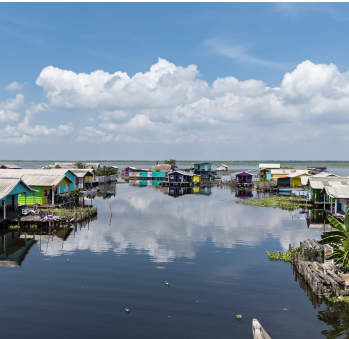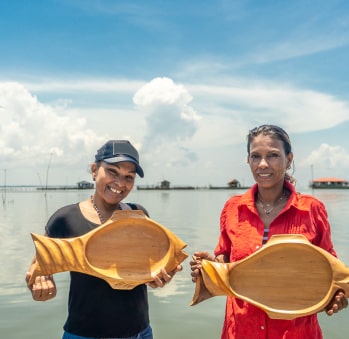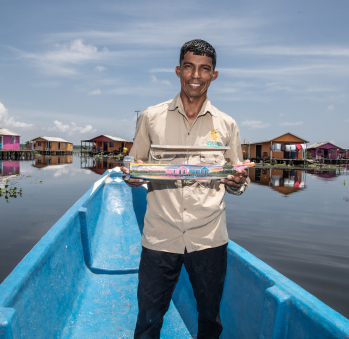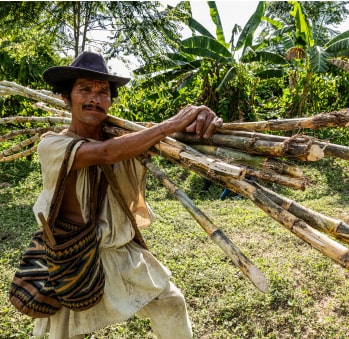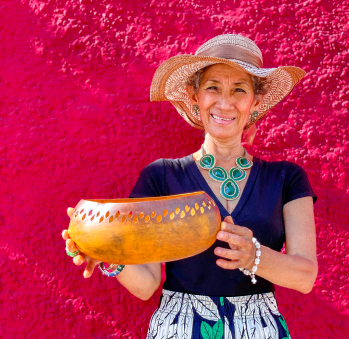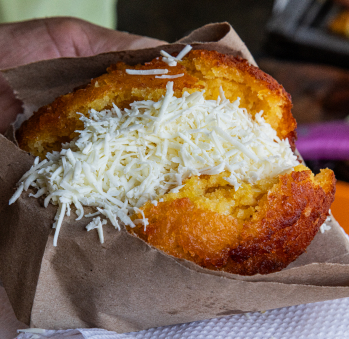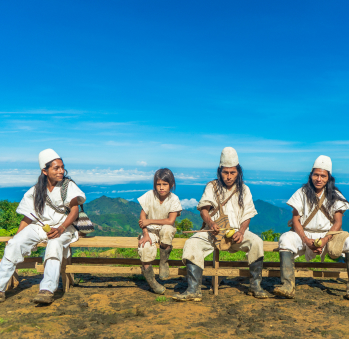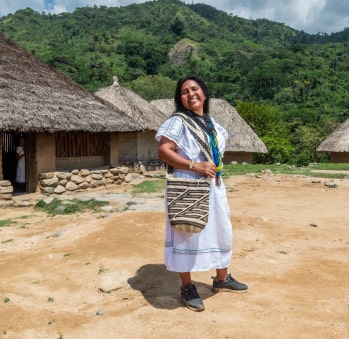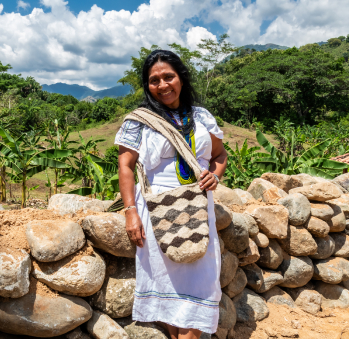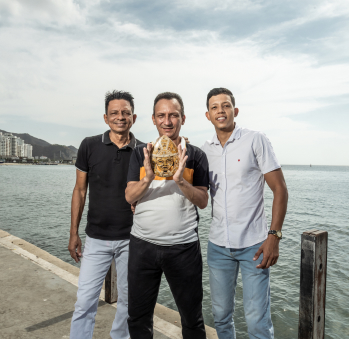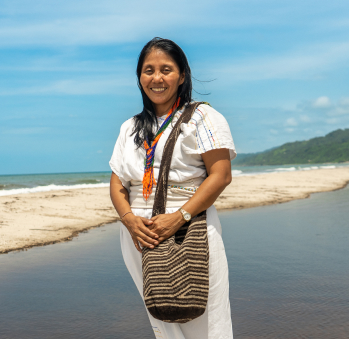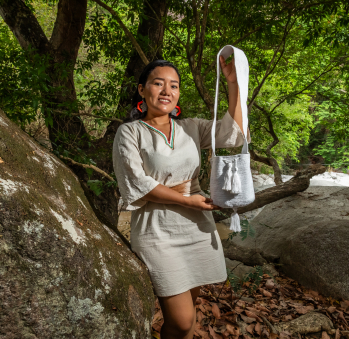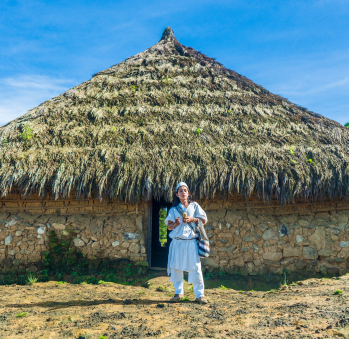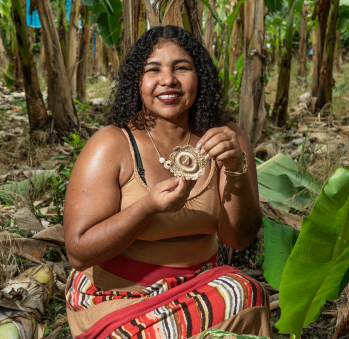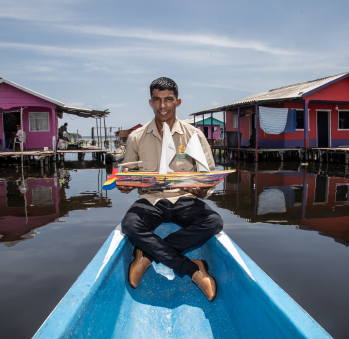Magdalena Route
LA SIERRA
This touristic cultural route, filled with acestrality and the ethnic cosmogony of the indigenous peoples who live in the Sierra Nevada de Santa Marta National Natural Park, the Arhuacos, Wiwa, and Kogui, will submerge you in a profound experience that will make your visit to the department of Magdalena unique. It is designed for those who are seeking a spiritual immersion in a landscape that is considered by its inhabitants as sacred. You must enter, climb the Sierra, and let yourself be guided by the land’s protectors. Depending on the time you want to spend on this trip, we offer you various intense and beautiful alternatives.
On the one hand, we suggest you visit the Busingueka reservation, one of the places where the Arhuaco siblings live. Here await majestic mountains and lagoons, as well as a community that will allow you to see and understand other ways of conceiving the world that are completely connected to nature. Getting to these landscapes will be without a doubt a reward because getting to this beautiful place will take you around six hours and several means of transportation. Quite an adventure!
With them, you will witness life among artisanal trades. You will see how, through mochila bags and baskets, their women weave thought. Also, you will discover other hierarchies and how they leave their big decisions in lives to their authorities. Without question, this will be an unforgettable and transformative experience.
But if you can’t make it up the Sierra and still want to discover the magic of the older siblings, you have another two incredible options at your disposal. In the foothills of the Sierra and just bordering the Caribbean Sea (via Palomino,) you will likewise be able to find the Kutunsama Arhuaco reservation. And if your route is along the El Rodadero road, you will find the Naara Kajmanta reservation of the Ette Enaka people. Both reservations will be splendid visits. You will have the opportunity to witness firsthand their rituals and the crafting of mochila bags by a group of empowered and marvelous craftswomen who have a lot to tell about their ancestors and their ideas of the future.
LA CIÉNAGA
This route also includes another look at the exhuberant Magdalena department: discovering its Ciénaga Grande.
Understanding this ecosystem, declared as a Natural Reserve of the Biosphere by the Unesco in the year 2000 due to its immense biodiversity, is becoming aware of a clear water rich in fauna and flora, harbor of migratory birds, postcard of sunsets. We want you to, aside from become dazzled with so much beauty, meet the neighbors of the Ciénaga and Pueblo Viejo towns: men and women who earn their livings mainly from fishing and whose craftspeople have traditionally focused on woodwork and the fruit of the totumo.
This will be an opportunity for you to stop along a road across which people normally travel so quickly and, with your sights already put on its landscape, learn about the cycles of water, as well as witness the increase of flow of many of the rivers that cross here. You will also have the chance to get on a boat and discover aquatic and lake-dwelling towns like Nueva Venecia. It is without a doubt another one of our country’s many gifts.
Embark on a journey full of history

Artisans along the way
Artisans along the way
We recommended this tour
Schedule the visit in advance with the artisans.
Carry cash
6 days
Medium
Car or bus and boat
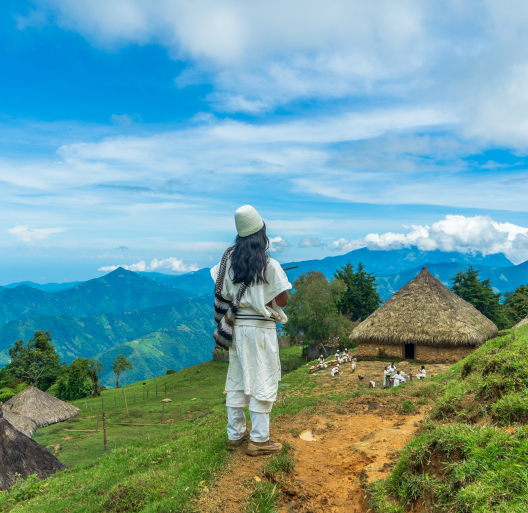
SANTA MARTA – RESGUARDO DE BUSINGUEKA
To reach this Arhuaco reservation of splendorous landscapes, you must leave for San Pablo (via Fundación) by bus. This will take around an hour. From there, leave for San Pedro by motorcycle (2 hours.) This is a road that has to be traveled through in 4×4 trucks or off-road motorcycles because it is not completely paved. Finally, and it is important for you to coordinate this with the members of the community who will receive you, you will go up to the Busingueka reservation by mule for 3 hours with them. Up there, you can stay in a communal house where you can hang your hammock. The landscape that you will find is lagoons (one and eight hours away by foot,) dense forests, a multiplicity of trees, and many butterflies. You will have the chance of seeing women weavers making their mochilas. You will learn the ABC’s of the trade from them, watching every single one of the processes involved, sharing with them around the fire, and listening to the teachings of the mamo, their highest authority.
Recommendations:
• Do not spend less than 3 days on this adventure, since arriving is an entire odyssey, even if it is worth it. Plan your trip in the summer season (November – February) because between March and October, the humidity of the terrain makes transport and comfort difficult for tourists.
• Before starting the route, ready your luggage: marsh boots, a good coat (temperature oscillates between 6 and 14 degrees,) water, a flash light, toilet paper, a hammock, cash, and snacks (you can program meals with your hosts, the members of the community: a sheep can cost 170,000 COP, between $30 and $40 USD; and a chicken, around $6 USD.)
SANTA MARTA – RESGUARDOS DE KUTUNSAMA Y NAARA KAJMANTA
• Via Palomino: Kutunsama (Arhuaco community): Go to Pericoguao, an hour and a half away from Santa Marta (65 kilometers.) Once you reach this point, you will have to walk more or less one hour inside the forest to the reservation. The town is beside the sea, and its authorities will welcome you (you must not look the mamo in the eyes out of respect,) since you will have to introduce yourself to them and tell them the reason for your visit. Do not forget to arrive with something to offer (coffee, beef, or chicken, for instance,) it is a courtesy that you have to act in accordance with because you are arriving at somebody’s house and you cannot get there with your hands empty. There, you will have the chance of seeing the women weavers, one of whom is Alcira Villafaña, and learn, from their hands and the mamos’, the profound meaning behind this artisanal trade.
• Via El Rodadero: Naara Kajmanta (Ette Enaka community): The best months in which to go are between November and February, since they are the summer. Before starting, pack mosquito repellent and water. Go to Puerto Mosquito, 12 kilometers away. At that point, you will have to take a motorcycle for half an hour to reach the community. The Gaira River is among the many attraction of this region’s landscape. Something that stands out in this place’s crafts are the whit mochila bags, exclusively made with cotton. Let yourself be welcomed by its authorities and by the weavers in charge of stories. You can spend a day visiting both of these communities and sharing with them.
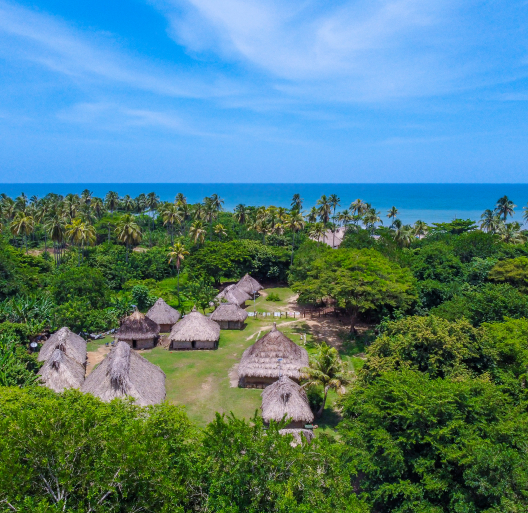
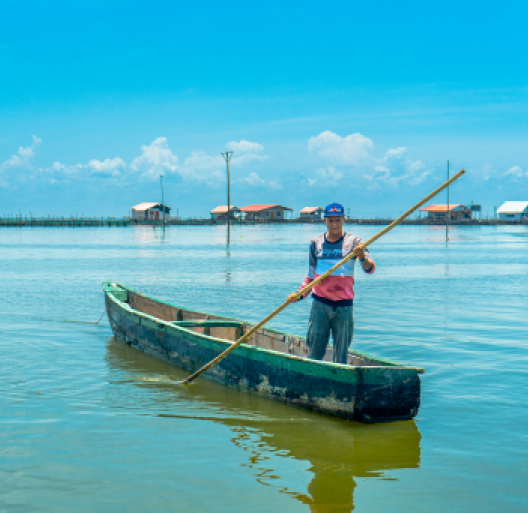
SANTA MARTA – CIÉNAGA – PUEBLO VIEJO
Welcome to the land of the Ciénaga Grande de Santa Marta Sanctuary of Flora and Fauna, a mere 34.5 kilometers away from the capital of Magdalena, some 45 minutes by car or public transport. There, aside from visiting this wonderful body of water, we suggest you stop in Ciénaga and Tasajera: towns that you will come across on your way and where the artisans we want you to meet live.
At Ciénaga, Heritage Town, you will not only meet the craftswomen who work with totumo, but you will also discover the rich cuisine of the region, which includes seafood casseroles, pork rinds, bollo limpio, cayeye plantain, three-phased sancocho, cooked bananas with cheese, shrimp rice, carimañolas, and arepa’e huevo. Quite the feast for the senses.
In addition, you can take the three-water (hot springs, sea, and river) tour and discover the republican architecture that Eduardo Carpentier (son of the famous writer) made in his Century Square (Plaza del Centenario,) which today the craftswomen use as inspiration to make the patterns of their designs.
SANTA MARTA – CIÉNAGA (LA Y) – ZONA BANANERA – ARACATACA
Saliendo de Santa Marta dirígete hacia la Y al lado de Ciénaga. Aquí tendrpas que seguir bajando hasta llegar a Zona Bananera, a 59,5 kms de la capital del departamento. Busca a Jackeline Mejía para que te cuente todo sobre el trabajo artesanal en calceta de plátano. Será una introducción ideal para que pases por Prado Sevilla, el lugar en donde se fundó la United Fruit Company, una sede que aún se mantiene en pie y que contrasta por su imponencia con el resto de paisaje. Ver ese lugar te permitirá entra en sintonía con el relato de las bananeras que tanto inmortalizó el Nobel. Termina tu paseo en Aracataca, a 2 horas de Santa Marta (84,5 kms), allí podrás conocer la casa donde nació Gabo, así como la casa del telegrafista y la estación del tren.
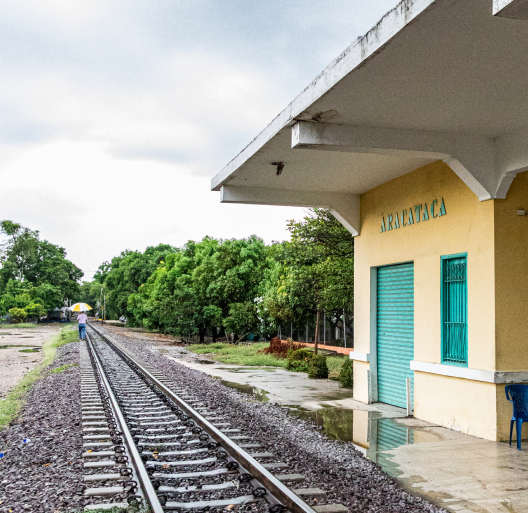
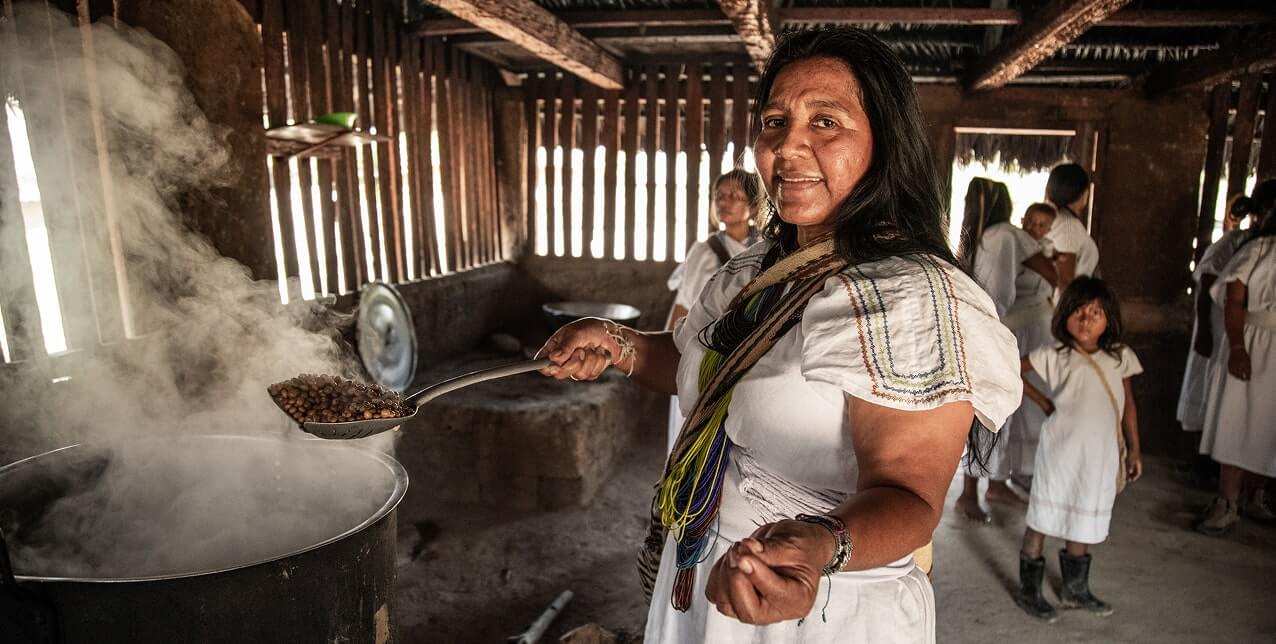
Traditional cuisine
and typical bites
Provoke yourself
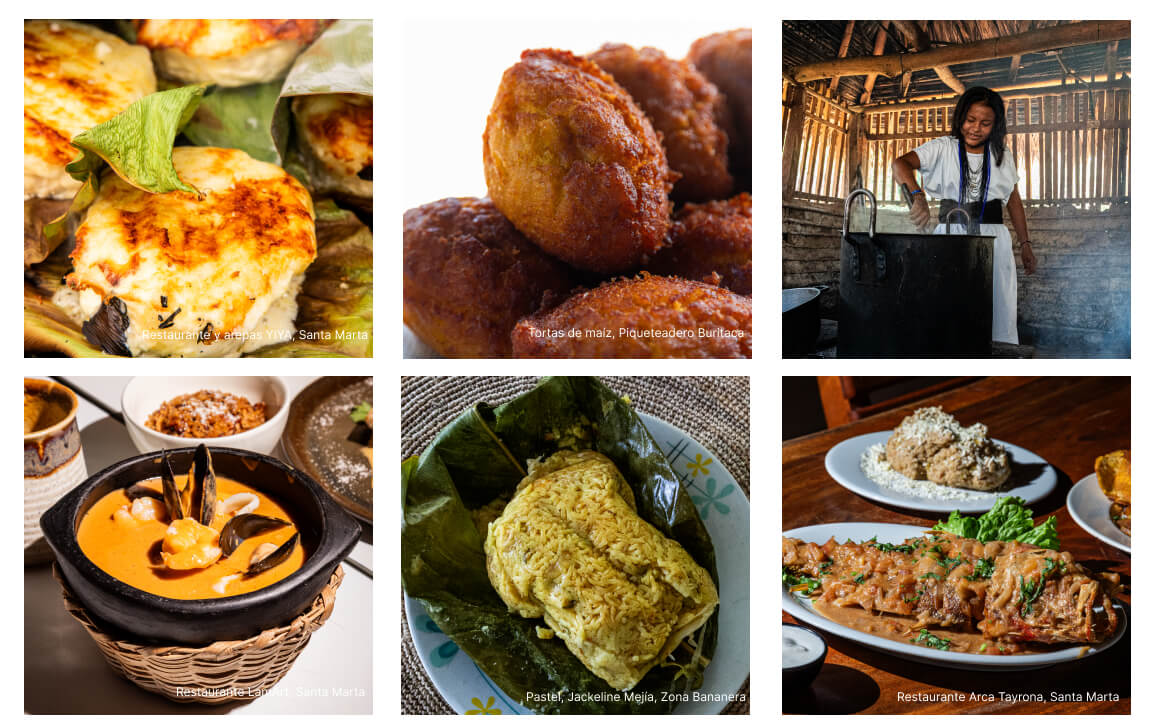
Don't leave without eating this 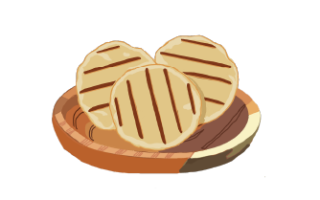
El cayeye o cabeza de gato es un puré de banano o guineo verde, que se mezcla con hogao, mantequilla y queso costeño. El restaurante Alfaix – Su Media Naranja, en Santa Marta, ofrece este delicioso plato. En Guasimo, también en la capital, encontrarás una presentación de vanguardia con sabores auténticos, lo mismo que en el restaurante LamArt, como acompañamiento de varios de sus platos como el róbalo en leche de coco. Este es un ingrediente fundamental y muy versátil de la cocina de esta zona. Tiene una textura cremosa y un sabor suave, ligeramente dulce y tropical, que aporta un toque especial a muchos de los platos de carnes, pescados y mariscos. En la gastronomía costeña, se usa para preparar salsas, guisos, sopas y postres, dándole un sabor muy original. Además, la leche de coco ayuda a realzar los sabores y aporta humedad y riqueza a las preparaciones típicas de la comida costeña. Además, en el Arca Tayrona frente al Parque Nacional Tayrona, en Ciénaga, los restaurantes Quile y El Turista venden este plato tradicional.
To lunch we go 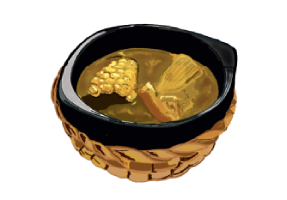
El salpicón de bonito (pez azul semejante al atún) es una receta muy tradicional que se prepara con este pescado seco al que se le agrega un buen sofrito de cebolla, tomate, ají dulce y achiote. Se sirve con bollo limpio y patacones o arroz con frijolito cabecita negra; en Santa Mesa, en Santa Marta, lo preparan con esta receta. Este pescado es la base de otras preparaciones típicas en estas tierras como es el arroz de bonito. Se prepara con bonito desmenuzado, sofrito, arroz, fondo de pescado y un poco de vinagre. Para resaltar el sabor se cubre con una hoja de bijao.
La Mojarra es un pescado de río que se come en la Costa, a la altura de la desembocadura del Magdalena y se reconoce por su frescura, y su delicado sabor. Se come generalmente frita y su inconfundible textura crocante brinda una experiencia culinaria auténtica y deliciosa, se sirve con los acompañamientos tradicionales (patacones, arroz con coco y ensalada), además de un buen jugo de corozo. El restaurante Donde Oneida, en Ciénaga, ofrece este rico plato. En Donde Chucho Gourmet, y en LamArt, en Santa Marta, también la puedes encontrar y en muchos restaurantes más por donde quiera que vayas, al ser una de las bases de la alimentación de esta región. En estos establecimientos también puedes optar por pargo rojo frito, bocachico con vitualla, huevas de pescado apanadas, viudo de pescado, arroz y sopa de mariscos y muchas otras delicias con pescados y mariscos de la zona.
El coctel de camarones es una preparación autóctona de la región que lleva jugo de limón, cebolla roja picadita, cilantro, ají dulce, ají picante y salsa de tomate; se sirve acompañado de patacones, galletas de soda o chips de plátano. En El Restaurante Popeye, de Pueblo Viejo, se puede probar este delicioso plato. En el Restaurante Siete Mares y LamArt, de Santa Marta, también lo puedes encontrar. Pero, eso sí, los mejores y más tradicionales cócteles cienagueros están en la Plaza del Centenario, donde el Gran Mañe.
Flavors to discover and snack on 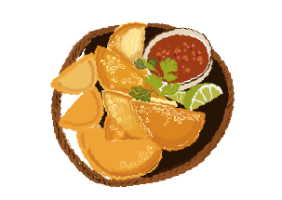
Los fritos de la costa como las arepas de huevo, los deditos de queso, los patacones y las papas rellenas, acompañados de suero y ají caseros con toques de ají dulce, hacen que las meriendas costeñas sean muy sabrosas. El restaurante Fritos A 500, en Ciénaga, ofrece gran variedad de ellos así como en las Casetas del Malecón, en Santa Marta, también se pueden encontrar. Además, a partir de las cinco de la tarde vale la pena ir hasta Donde Yiya y hacer la fila por una arepa de maíz blanco rellena de queso, asada al carbón sobre hoja de bijao. La corteza es dorada y crocante y el interior esponjoso.
Y prueba las hallacas preparadas con masa de harina de maíz rellenas de pequeños trozos de cerdo y pollo guisados con verduras y achiote, envueltas en hoja de bijao que se cocina en fogón de leña en Hallaca Tropical, en Santa Marta.
To sweeten the palate and unmissable drinks 
Los jugos de fruta, de banano, mango, níspero, tamarindo, corozo, guanábana y zapote se pueden encontrar en La Plazoleta de Jugos Santa Marta en el Malecón de Bastidas. Tómalos preparados en agua o en leche, bien fríos. Y Donde Yiya puedes acompañar la arepa con una refrescante chicha de arroz; arroz cocido en abundante agua y saborizado con canela y vainilla.
El café de la Sierra Nevada de Santa Marta cuenta con sello de denominación de origen protegido y es muy apetecido por los extranjeros. Es de sabor suave con notas a chocolate y está cultivado, principalmente, por indígenas arhuacos. La Fundación Wirakoku, que lidera la artesana Lucelly Torres en su resguardo y en Santa, así como La Comercializadora De Café De La Sierra, en Ciénaga, tuestan y comercializan este delicioso café. En Santa Marta se destaca Lulo Café Bar, por su oferta de Café de la Sierra Orgánico e Ikaro Café por usar diferentes métodos en sus preparaciones.
Las Cocadas son dulces típicos colombianos que se hacen con leche y azúcar o a partir de un melado de panela con coco rallado que se deja endurecer y se moldea con cucharita; puede llevar aliños como canela y clavos. En Santa Marta se pueden disfrutar en la Dulcería Ricuras De Mi Costa.
Los Raspaos hechos a partir de hielo raspado son un dulce frío y refrescante para el calor de la costa colombiana. Prueba sabores como el maracumango (mezcla de maracuyá y mango), guanábana, tamarindo y lulo en el puesto ambulante Raspados y Cholados El Tigre que se encuentra ubicado frente a la entrada del cementerio del centro en Santa Marta.
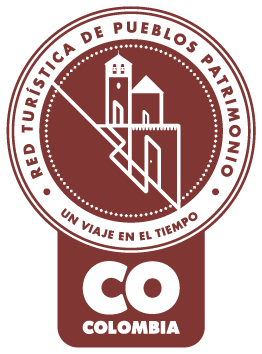
Pueblo Patrimonio
La Red Turística de Pueblos Patrimonio de Colombia es un programa especial del Ministerio de Comercio, Industria y Turismo, ejecutado por FONTUR, que trabaja con 17 municipios de Colombia que poseen declaratoria de Bien de Interés Cultural (BIC) a nivel nacional para su valoración y proyección mediante el turismo, generando así más oportunidades de desarrollo y sostenibilidad en las comunidades.

La Medalla a la Maestría Artesanal es un galardón que Artesanías de Colombia entrega anualmente, con el cual se hace un reconocimiento a aquellos artesanos, empresas y comunidades artesanales que, contando con una trayectoria destacada, sobresalen a nivel nacional por su excelencia en el oficio así como por preservar el quehacer artesanal.

Denominación de Origen
Es un signo distintivo que identifica productos reconocidos o famosos por tener una calidad o características específicas derivadas esencialmente del lugar de origen y la forma tradicional de extracción, elaboración y producción por parte de sus habitantes. La protección conferida sobre una Denominación de Origen implica que ninguna persona puede identificar con la denominación protegida productos iguales o similares a los amparados, cuando no provengan del verdadero lugar y no cumplan con las características o calidades que le han dado la reputación al producto reconocido. Las Denominaciones de Origen para productos artesanales colombianos que han sido protegidas por la Superintendencia de Industria y Comercio en nuestro país son actualmente 12.
No puede copiar contenido de esta página









































